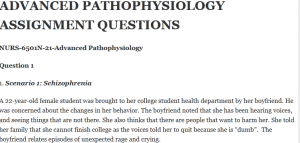ADVANCED PATHOPHYSIOLOGY ASSIGNMENT QUESTIONS

NURS-6501N-21-Advanced Pathophysiology
Question 1
1. Scenario 1: Schizophrenia
A 22-year-old female student was brought to her college student health department by her boyfriend. He was concerned about the changes in her behavior. The boyfriend noted that she has been hearing voices, and seeing things that are not there. She also thinks that there are people that want to harm her. She told her family that she cannot finish college as the voices told her to quit because she is “dumb”. The boyfriend relates episodes of unexpected rage and crying.
PMH: noncontributory
FH: positive for a first cousin who “had mental problems”.
SH: Denies current drug abuse but states he smoked marijuana every day during junior and senior years of high school. Admits to drinking heavily on weekends at various fraternity houses.
PE: thin, anxious disheveled female who, during conversations, stops talking, tilts her head and appears to be listening to something. There is poor eye contact and conversation is disjointed.
DIAGOSIS: schizophrenia.
Question: What are known characteristics of schizophrenia and relate those to this patient.
ANSWER
Question 2
Scenario 1: Schizophrenia
A 22-year-old female student was brought to her college student health department by her boyfriend. He was concerned about the changes in her behavior. The boyfriend noted that she has been hearing voices, and seeing things that are not there. She also thinks that there are people that want to harm her. She told her family that she cannot finish college as the voices told her to quit because she is “dumb”. The boyfriend relates episodes of unexpected rage and crying.
PMH: noncontributory
FH: positive for a first cousin who “had mental problems”.
SH: Denies current drug abuse but states he smoked marijuana every day during junior and senior years of high school. Admits to drinking heavily on weekends at various fraternity houses.
PE: thin, anxious disheveled female who, during conversations, stops talking, tilts her head and appears to be listening to something. There is poor eye contact and conversation is disjointed.
DIAGOSIS: schizophrenia.
Question: Genetics are sometimes attached to schizophrenia explain this.
ANSWER
Question 3
Scenario 1: Schizophrenia
A 22-year-old female student was brought to her college student health department by her boyfriend. He was concerned about the changes in her behavior. The boyfriend noted that she has been hearing voices, and seeing things that are not there. She also thinks that there are people that want to harm her. She told her family that she cannot finish college as the voices told her to quit because she is “dumb”. The boyfriend relates episodes of unexpected rage and crying.
PMH: noncontributory
FH: positive for a first cousin who “had mental problems”.
SH: Denies current drug abuse but states he smoked marijuana every day during junior and senior years of high school. Admits to drinking heavily on weekends at various fraternity houses.
PE: thin, anxious disheveled female who, during conversations, stops talking, tilts her head and appears to be listening to something. There is poor eye contact and conversation is disjointed.
DIAGOSIS: schizophrenia.
Question: What roles do neurotransmitters play in the development of schizophrenia?
ANSWER
Question 4
Scenario 1: Schizophrenia
A 22-year-old female student was brought to her college student health department by her boyfriend. He was concerned about the changes in her behavior. The boyfriend noted that she has been hearing voices, and seeing things that are not there. She also thinks that there are people that want to harm her. She told her family that she cannot finish college as the voices told her to quit because she is “dumb”. The boyfriend relates episodes of unexpected rage and crying.
PMH: noncontributory
FH: positive for a first cousin who “had mental problems”.
SH: Denies current drug abuse but states he smoked marijuana every day during junior and senior years of high school. Admits to drinking heavily on weekends at various fraternity houses.
PE: thin, anxious disheveled female who, during conversations, stops talking, tilts her head and appears to be listening to something. There is poor eye contact and conversation is disjointed.
DIAGOSIS: schizophrenia.
Question: Explain what structural abnormalities are seen in people with schizophrenia.
ANSWER
Question 5
1. Scenario 2: Bipolar Disorder
A 44-year-old female came to the clinic today brought in by her husband. He notes that she has been with various states of depression and irritability over the past 3 months with extreme fatigue, has lost 20 pounds and has insomnia. He has come home from work to find his wife sitting in front of the TV and not moving for hours. In the past few days, she suddenly has become very hyperactive, has been talking incessantly, has been easily distracted and seems to “flit from one thing to another .”. She hasn’t slept in 3 days. The wife went on an excessive shopping spree for new clothes that resulted in their credit card being denied for exceeding the line of credit. The wife is unable to sit in the exam room and is currently pacing the hallway muttering to herself and is reluctant to talk with or be examined the ARNP. Physical observation shows agitated movements, rapid fire speech, and hyperactivity.
DIAGNOSIS: bipolar type 2 disorder.
Question: How does genetics play in the development of bipolar 2 disorders?
ANSWER